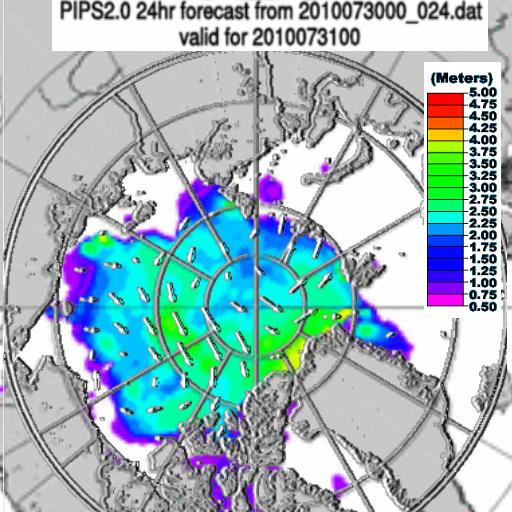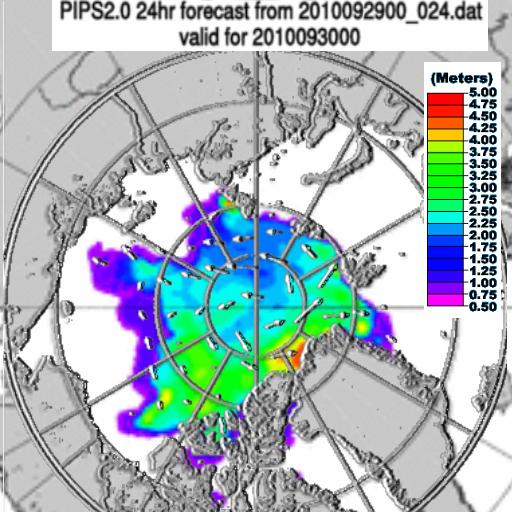PIPS shows that 3 metre thick ice nearly doubled in area between July and September.


July 31 – Average thickness 2.1 m September 30 – Average thickness 2.2 m
A slightly different view of the world than NSIDC.
PIPS shows that 3 metre thick ice nearly doubled in area between July and September.


July 31 – Average thickness 2.1 m September 30 – Average thickness 2.2 m
A slightly different view of the world than NSIDC.
PIPS = Polar Ice Prediction System.
When looking at past events, why look at old Predictions instead of actual Observations?
They predict one day in advance.
Not very well by the looks of things.
That is why those Navy nuclear subs are crashing all the time.
With an average 1m thickness I don’t think the sub has much to worry about.
Next time you crash your car, tell the officer that the average traffic density was low.
Comment from a previous post regarding surfacing through ice: http://stevengoddard.wordpress.com/2010/09/21/is-the-ice-getting-thicker/#comment-1739
Also: http://stevengoddard.wordpress.com/2010/09/21/is-the-ice-getting-thicker/#comment-1458
“If a submarine captain wants to surface, he or she would presumably use the submarine’s sonar, which would give much more direct data than any model.”
And he would first use a map to locate a suitable region to start looking.
And what study compares their predictions with observations?
Brendon says:
October 8, 2010 at 6:06 am
And what study compares their predictions with observations?
Why don’t you tell us Brendon? You’re acting like the smart one in the room.
It is so odd that people are still arguing about PIPS.
Tell me: who is making “observation” on ice thickness?
Tell me, Brendon, who it is that keeps ice thickness observation of the Arctic? And what is it specifically they are doing to do the observing?
Isn’t there a PIPS 3.0 system now?
Sure. Send me the link when you find it.
Ask the Navy subs that aren’t crashing. 😉
PIPS2 is the Navy’s operational ice forecast system.
Brendon says:
October 8, 2010 at 4:54 am
Isn’t there a PIPS 3.0 system now?
Brendon,
You know EVERYTHING. Why would you ask?
Steve, I’m confused how you can do pixel counting on these images, when certain colors are repeated for varying values; #00FF00 is the color for the ranges 2.75-3.0, 3.0-3.25 and 3.25-3.5. Likewise, #0000FF is the color for the three ranges between 1.0 and 1.75.
You clearly have specific values for each of these ranges that occupy the same colorspace. How do you kn0w if a pixel with a color value #0000FF is in the range 1.0-1.25, 1.25-1.5 or 1.5-1.75?
I see that you are hosting these images (again) locally. Do you use different images for your analysis than you are showing in your posts?
The colors are blended. You have to establish a reasonable tolerance and work within that.
bbttxu
what does your count show?
bbttxu says:
October 8, 2010 at 4:56 am
I see that you are hosting these images (again) locally.
You are making an issue out of NOTHING.
Amino,
Hosting images locally is only an issue if the original data is different from what is being shown to you and I here. And in this case it is.
PIPS scale only has one region that share the same color. (3.0-3.25,3.25-3.5)
Steve’s superimposed scale has two, larger regions that share the same color: (1.0-1.25, 1.25-1.5, 1.5-1.75) and (2.75-3.0, 3.0-3.25 and 3.25-3.5).
This may or may not significantly affect the results. Steve doesn’t indicate whether he used the original values for thickness in his analysis, or used his altered thickness scale.
I wish I could throw together a pixel counting routine that handles incremental color variations overnight, but I’m just not that good. 🙂 Perhaps Steve, you could share your code used in your analysis?
bbttxu
you make assumptions
They aren’t assumptions, Amino, they are questions. If you look at the maps, you’ll see that several ranges appear to share the same color, yet in the graph they have different pixel counts.
There is nothing unreasonable in politely asking about the methodology, as bbttxu has done.
Steven Goddard,
After reading all these experts here talking about PIPS, I see that you said in jest one time is true:
What would the Navy with all its subs in the Arctic know about Arctic Ice?
You’re right. They’re just out there every day. They aren’t sitting in an office in front of a computer with a PhD hanging on the wall. What could they know? Poor misinformed blokes. If they had only gone to the right schools….. dam their on hands experience! What good has it done them!! Heck, they could have been here right now reading comments posted by Brendon and bbttxu! Oh… if only they’d known, then we would be so much safer from the Russians and Chinese!! And they would have accurate ice data too! Well, you can’t win em all. The Navy will just have to make due with first hand knowledge they get while in those subs that don’t have PhD’s on the wall. What a waste! Well, there’s your government money at work for you!
sarc off (in case anybody didn’t already know)
Amino, these are perfectly valid questions. PIPS is a computer model for predicting ice thickness. The images Steve shows here don’t represent observations. They are the output of the computer model, yet they are presented here as though they are observational.
Given the skeptical community’s view of the reliability and usefulness of computer models, I have to say that treating model output as though it were factual borders on the hypocritical.
As for the subs, yes, they’re out there every day. But they cover only a minute fraction of this area, and we don’t know how well their observations match the model output. And I’ll give you a 100% gold-plated guarantee that they don’t rely on it to avoid crashing, as Steve implies above. That’s just silly.
They obviously update their models with real data on a regular basis – just as weather forecasters do.
The second “P” in “PIPS” stands for prediction. This is an ice forecast based on a computer model. You don’t say so, and you treat it as observational data. It doesn’t “show” that thick ice doubled, as you claim, by any stretch of the imagination. This is disingenuous to say the least.
Steven Goddard,
for what it’s worth,
it’s true that people see what they want to see. I have noticed that ChrisD has probably the severest case of that.
Amino, perhaps you could point out exactly what was incorrect about what I said.
Would you have known that this was a computer model prediction, not observational data, if none of the comments had pointed that out?
Do you think that the difference between observational data and computer model predictions is not significant?
Thank you.
People that are basing their belief on an ice free Arctic are doing so on the hypothesis that manmade co2 controls climate. And, since manmade co2 continuies to rise so will temperature, they believe.
As time goes by there is more and more evidence that shows co2, manmade or otherwise, does not control climate. But there are people still believing it.
The projection that the Arctic will be ice free in about 30 years (or whatever they say) will not be happening if any of the parameters of their prediction don’t pan out. If the earth cools for the next 20 to 30 years there will be no ice free Arctic.